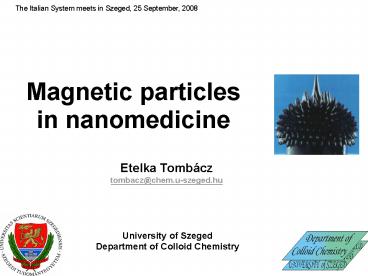Magnetic particles in nanomedicine - PowerPoint PPT Presentation
1 / 15
Title:
Magnetic particles in nanomedicine
Description:
Reduction in the side effects of chemotherapy: decrease in dose ... Reduction in the dose of chemotherapy, so the side effects, too. ... – PowerPoint PPT presentation
Number of Views:341
Avg rating:3.0/5.0
Title: Magnetic particles in nanomedicine
1
Magnetic particles in nanomedicine
The Italian System meets in Szeged, 25 September,
2008
- Etelka Tombácz
- tombacz_at_chem.u-szeged.hu
University of Szeged Department of Colloid
Chemistry
2
(No Transcript)
3
Magnetic particles
such as magnetic iron oxides (magnetite,
maghemite) can obviously interact with
external magnetic field depending on the size of
magnetic particles in the range of micrometer
(10-6 m) and nanometer (10-9 m) the
particles move the whole liquid can move
Microparticles
Nanoparticles
superparamagnetic particles dispersed in liqiud
? magnetic fluids (MFs)
4
Magnetic fluids (MFs)
- superparamagnetic particles dispersed in
carrier liquids, - the whole liquid can move in
the inhomogeneous magnetic field, so MFs can be
manipulated by external magnets
5
Biomedical applications
The most important applications MRI contrast
agent diagnosis magnetic cell labeling and
separation - therapy magnetic hyperthermia -
therapy targeted drug delivery - nanomedicine
Criteria these applications require the magnetic
nanoparticles to be non-toxic,
chemically stable, uniform in size, and
well-dispersed in aqueous media.
Magnetic nanoparticles are of magnetite and
maghemite dominantly, because living systems
know what to do with them, iron oxides are
excreted via the liver after the treatment.
Particle aggregation must be excluded in magnetic
field during application with reference to the
danger of embolism in blood vessel.
6
Magnetic resonance imaging - MRI
At present, gadolinium complexes are used ?
water pollution problem, e.g., in the Danube
Biocompatible water based MFs (e.g. magnetit
nanoparticles stabilized by dextrane) in the
blood wessels
gadoliniumdiethylenetriamine penta-acetic acid
J. P. Hornak
7
Targeted drug delivery
- Goal
- Reduction in the side effects of chemotherapy
- decrease in dose
- treatment of malignant cells only
- save money
Chemoterapy traditional
Magnetic fluid
Magnetic targeted carrier
ZM Saiyed et al., BioMagnetic Research and
Technology,(2003)
C. Alexiou et al., Eur Biophys J., (2006)
8
Magnetic hyperthermia
Local heat evolution due to either the relaxation
losses for superparamagnetic particles (Neel
relaxation) or the frictional losses of particles
(Brownian motion).
at least 42 C for 30 minutes in AC field
- Advantages
- Reduction in the dose of chemotherapy, so the
side effects, too. - Malignant cells are more sensitive to the rise
in temperature than healthy ones.
9
Combination of therapies hyperthermia -targeted
drug delivery
- Through folate receptors
- 1000 times more on the surface of malignant cells
- Magnetic nanoparticles with folates
- Magnetic nanoparticles with folates
effective agent
hyperthermia
targeted drug delivery hyperthermia
Endocyte Inc .
10
Combination of diagnosis and therapy
MRI hyperthermia targeted drug delivery
E.S. Papazoglou A. Parthasarathy,
BioNanotechnology (2007)
11
Synthesis magnetite nanoparticles
FeCl2, FeCl3
pH7.8
lúgos hidrolízis
Fe3O4
10nm
Magnetite
HR-TEM
TEM
XRD
E. Illés, E. Tombácz, J. Colloid Interface Sci.,
295, 115-123. 2006.
E.Tombácz, et al., Croatica Chemica Acta 80
(2007) 503-515.
12
Coating particle surface to prevent aggregation
A. Hajdú, E. Tombácz, E.Illés D. Bica, L. Vékás
Magnetite nanoparticles stabilized under
physiological conditions for biomedical
application, Progress in Colloid and Polymer
Science (in press)
Magnetite nanoparticles stabilized by citric acid
the most common
Iron dissolution
Stability problem low salt tolerance
Anti-coagulant like HEPARIN
13
Coating particle surface to prevent aggregation
Magnetite nanoparticles stabilized by surfactant
double layers
Increasing amount of fatty acid
Combined electrostatic and steric effects to
hinder particle adhesion Excellent stability
under physiological condition Supramolecular
structure is analogous to liposome - promishing
E.Tombácz, D.Bica, A.Hajdú, E.Illés, A.Majzik,
L.Vékás Surfactant double layer stabilized
magnetic nanofluids for biomedical application,
Journal of Physics Condensed Matter 20 (2008)
204103
14
Effect on the HeLa cells
Nikon Eclipse inverted microscope Nikon D 50
digital camera
Studied by B.Réti and I.Zupkó
MTT assay
No citotoxic effect
Control
Citrate stabilized magnetite
15
Thanks
my colleagues for the excellent work,
Magnetic Fluid Laboratory at CFATR, Romanian
Academy-Timisoara, Romania Department of
Pharmacodynamics and Biopharmacy, Faculty of
Pharmacy for collaboration,
the grant NKTH-OTKA (A7-69109/2007) for financial
support,
and you for kind attention!































